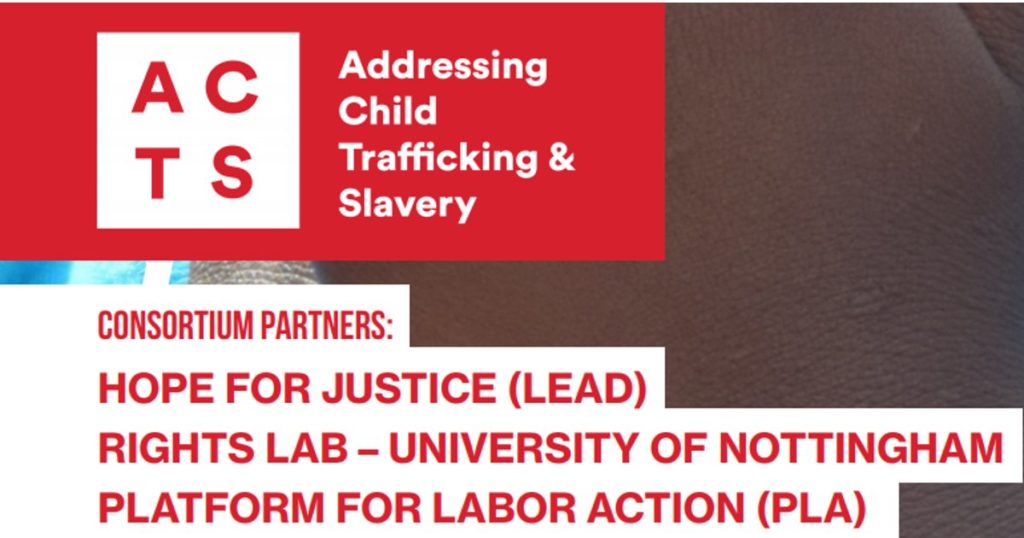Shared measurement in anti-trafficking coalitions
Guest blog by Dr. Emily Wyman, Rights Lab; Patrick Munduga, ANCHOR; Esther Weir, Rights Lab
The anti-trafficking sector is facing a crisis in shared measurement. The largest repository of anti-trafficking project and program evaluations highlights that low numbers of evaluations are being generated and shared publicly. Alongside this, there is a startling lack of standardization in data collection across organizations and sectors (Promising Practices Database, Walk Free 2022). This fundamentally limits the sectors' capacity to monitor and understand the relative impact of interventions – or ‘what works' – at scale (Davy, 2016; Bryant & Landmann, 2019; ICAT, 2016 a and b).
Large shocks caused by phenomena such as pandemics, economic recessions, environmental and climate change events, geo-political conflicts and forced migrations exacerbates both Trafficking in Human Beings and factors that place people at increased risk. These could be displacement, poverty, and lack of other socio-economic opportunities. If the anti-trafficking sector cannot have a clear measurement of the impact of their programs prior to shocks, nor an accurate way of measuring change in impact during shocks, it limits their opportunity to adapt to these events and develop programs that are responsive at the core.
Coalitions of civil society organizations (CSOs) on the anti-trafficking frontline are in a unique position to collect monitoring data for two main reasons:
1. Coalitions, by definition, have already brought organizations together around a common objective to catalyze their individual efforts and achieve collective leverage; collective learning; collective security; collective visibility and access to resourcing to increase their impact. In this context, it could be to increase protection of persons with lived experiences; prevention through reduction of root causes; prosecution of relevant crimes; and influence policy change.
2. Many individual organizations within the coalition may be collecting their own data on their anti-trafficking efforts and directly monitoring trends to inform their intervention work at ground level. Even without purposeful monitoring, individual organizations may be collecting the data needed to identify and analyze these trends across the sector.
One example of this is a recent pilot project by the Malawi Network Against Trafficking (MNAT) and the Freedom Collaborative. These groups sought to tap into their extensive membership to explore how a shared measurement approach could be established for generating collective data. With data from only six members, it was possible to map out 44 child trafficking routes and glean important operational insights from the data (e.g. on mode of transport being used) with practical implications for national transit monitoring. Another example is the work achieved by the Coalition against Trafficking in Persons – Uganda (CATIP-U).
CATIP-U is a membership alliance of over 40 CSOs working to end human trafficking in Uganda. CATIP-U members recognized that in trying to work alone, they may not fully appreciate the array of needs that must be addressed to effectively counter trafficking in persons (TIP). When CATIP-U's diverse group of CSO service providers and representatives came together to share different perspectives, experiences, and expertise, they found new and creative solutions emerged to meet the dynamic challenges of anti-trafficking in Uganda.
Addressing Child Trafficking and Slavery (ACTS) Project

The ACTS project recognized the critical anti-trafficking force that the CATIP-U Coalition represents in Uganda and sought to support ongoing Coalition strategy development by collaboratively exploring shared measurement practice with the Coalition. The Africa Non-profit Chore (ANCHOR, a member of the CATIP-U Board of Directors) facilitated the development of the Coalition's 2021-25 Strategic Plan which flagged interest in – and potential for – shared measurement in the Coalition. The University of Nottingham Rights Lab facilitated development of the Coalition's shared measurement framework in partnership with Hope for Justice and ANCHOR. This work was funded by the U.S. Department of State through GFEMS as part of the ACTS project.
The implementation of the shared measurement system in the CATIP-U Coalition will facilitate the implementation of CATIP-U's strategic plan which, among other things, seeks to strengthen evidence-based decision making at national and sub-national levels. The longer-term impacts sought include improving access to services for survivors, and creating strategic national and international partnerships to:
1. Strengthen trust and influence at the community level far more than what may be commanded by individual member organizations;
2. Increase access to decision makers and increase opportunities to obtain services and other benefits;
3. Gain increased access to funding opportunities that may require member collaboration;
4. Improve stakeholder perceptions of member organizations working in partnership.
Challenges in developing shared measurement approaches
The examples of MNAT, the Freedom Collaborative and CATIP-U also highlighted important practical challenges in developing shared measurement systems such as achieving genuine buy-in to data sharing practices from member organizations and establishing mechanisms for data collection, analysis and application. These kinds of challenges are widespread in large part because, historically, coalition member organizations do not start out as members with aligned objectives and measurement systems but come together after their foundation to align and build collective impact.
This presents various challenges for shared measurement and the generation of collective data:
1. Strategic development: Coalitions seeking to adopt shared measurement practices need to define shared activities, outcomes, indicators, and definitions for indicators. For example, to adopt a shared approach to collecting data on the ‘number of people receiving service X' the terms ‘receiving' and ‘service X' both require a common definition – not a trivial task when CSOs are delivering slightly different services or similar services but in different ways.
2. Data and information management: the collecting, sharing and storage of data need to be managed ethically with privacy and security at the forefront to protect those to whom the data relates.
3. Guidance resources: There is a lack of bespoke resources for anti-trafficking monitoring, evaluation and learning (MEL) and data management, and those that exist are distributed widely. Many are designed for organizations with significant time, resource and / or technical MEL capability, and most are produced in English (with limited availability in other major languages, mostly French and Spanish).
4. Funding: Funding allocation for MEL for individual CSOs is typically limited, e.g., by percentage limits on project and program MEL activities. Sectoral developments have led to increasing demands for MEL to fulfil evolving requirements (around e.g. outcome assessment, participation, disaggregation to support nuanced analysis, safeguarding due diligence, reporting standards, etc.). To date, expectations of the overall project landscape have not developed to accommodate these additions. There has been limited recognition of the additional resources required to deliver on these requirements. GFEMS is notable among a small number of donors whose approach and resourcing supports efforts towards this.
Furthermore, the collation and analysis of data from CSOs requires resources. Funding beyond that provided to individual organizations is needed to be able generate collective insights. In many cases the responsibility lies with anti-trafficking research and MEL practitioners and networks to demonstrate / showcase the power of collective data insights and produce resources and tools to support and enhance them.
Project Learnings
Despite the challenges there are a number of identified learnings that those who wish to develop shared measurement standards, either as part of a coalition or between partners in the sector, can apply to their efforts.
1. Identify MEL and measurement barriers that coalition members face early on. Are they mainly incentive issues (e.g., members do not recognize the value) or logistical issues (time and resources are the central issue) or both?
2. Address MEL and measurement barriers in a bespoke fashion: Where MEL capacity emerges as a key barrier, building and increasing access to MEL support can help garner trust and interest in data collection and sharing. Where the value of shared measurement and collective data insights is unclear to members, it can be useful to examine examples of where it has produced useful operational data. Similarly, linking the process to outcomes that address prevailing challenges for coalition members (e.g., organizational sustainability and funding) can help to secure meaningful participation.
3. The development of shared measurement systems is a process: Start with defining common activities and implementation (or ‘output') indicators first. Shared definitions for indicators come next. These form the foundation on which outcome indicators can be developed. Similarly, start by prioritizing data collection and collation using indicators that members already collect data on, since these present low start-up costs!
4. Share learnings: Sharing good practices and common obstacles is helpful for other coalitions. Cumulatively building a picture of ‘good practices', will enable other coalitions in the sector to develop shared measurement systems with less time and resources and benefit the whole sector.
5. Remember that challenges in developing shared measurement approaches apply across the sector, and outside it: Cross-organizational shared measurement is not straightforward and needs to be co-developed through collaborative dialogue between coalition members in which a range of voices are heard and heeded.
Conclusion
The essential value of shared measurement is that it produces standardized data across organizations that can be integrated and analyzed to enhance anti-trafficking work in ways that no organization can achieve alone. The broader consequence of this form of collective impact strategy is that we can improve our understanding in the anti-trafficking sector of what works to end trafficking.
This blog post was made possible through support provided by the Global Fund to End Modern Slavery under a grant from the U.S. Department of State. The opinions expressed herein are those of the author(s) and do not necessarily reflect the views of GFEMS or the U.S. Department of State.

This “Eyes on Trafficking” story is reprinted from its original online location.
 ABOUT PBJ LEARNING
ABOUT PBJ LEARNING
PBJ Learning is a leading provider of online human trafficking training, focusing on awareness and prevention education. Their interactive Human Trafficking Essentials online course is used worldwide to educate professionals and individuals how to recognize human trafficking and how to respond to potential victims. Learn on any web browser (even your mobile phone) at any time.
More stories like this can be found in your PBJ Learning Knowledge Vault.
EYES ON TRAFFICKING
This “Eyes on Trafficking” story is reprinted from its original online location.
ABOUT PBJ LEARNING
PBJ Learning is a leading provider of online human trafficking training, focusing on awareness and prevention education. Their interactive Human Trafficking Essentials online course is used worldwide to educate professionals and individuals how to recognize human trafficking and how to respond to potential victims. Learn on any web browser (even your mobile phone) at any time.
More stories like this can be found in your PBJ Learning Knowledge Vault.
